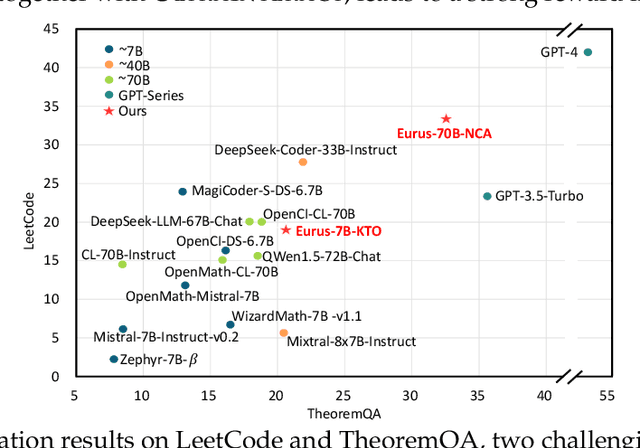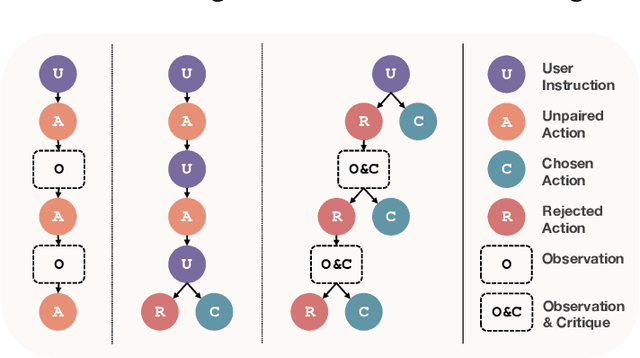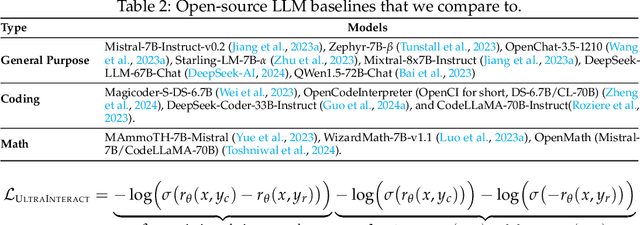Xingyao Wang
Agent KB: Leveraging Cross-Domain Experience for Agentic Problem Solving
Jul 08, 2025Abstract:As language agents tackle increasingly complex tasks, they struggle with effective error correction and experience reuse across domains. We introduce Agent KB, a hierarchical experience framework that enables complex agentic problem solving via a novel Reason-Retrieve-Refine pipeline. Agent KB addresses a core limitation: agents traditionally cannot learn from each other's experiences. By capturing both high-level strategies and detailed execution logs, Agent KB creates a shared knowledge base that enables cross-agent knowledge transfer. Evaluated on the GAIA benchmark, Agent KB improves success rates by up to 16.28 percentage points. On the most challenging tasks, Claude-3 improves from 38.46% to 57.69%, while GPT-4 improves from 53.49% to 73.26% on intermediate tasks. On SWE-bench code repair, Agent KB enables Claude-3 to improve from 41.33% to 53.33%. Our results suggest that Agent KB provides a modular, framework-agnostic infrastructure for enabling agents to learn from past experiences and generalize successful strategies to new tasks.
LocAgent: Graph-Guided LLM Agents for Code Localization
Mar 12, 2025



Abstract:Code localization--identifying precisely where in a codebase changes need to be made--is a fundamental yet challenging task in software maintenance. Existing approaches struggle to efficiently navigate complex codebases when identifying relevant code sections. The challenge lies in bridging natural language problem descriptions with the appropriate code elements, often requiring reasoning across hierarchical structures and multiple dependencies. We introduce LocAgent, a framework that addresses code localization through graph-based representation. By parsing codebases into directed heterogeneous graphs, LocAgent creates a lightweight representation that captures code structures (files, classes, functions) and their dependencies (imports, invocations, inheritance), enabling LLM agents to effectively search and locate relevant entities through powerful multi-hop reasoning. Experimental results on real-world benchmarks demonstrate that our approach significantly enhances accuracy in code localization. Notably, our method with the fine-tuned Qwen-2.5-Coder-Instruct-32B model achieves comparable results to SOTA proprietary models at greatly reduced cost (approximately 86% reduction), reaching up to 92.7% accuracy on file-level localization while improving downstream GitHub issue resolution success rates by 12% for multiple attempts (Pass@10). Our code is available at https://github.com/gersteinlab/LocAgent.
The Danger of Overthinking: Examining the Reasoning-Action Dilemma in Agentic Tasks
Feb 12, 2025Abstract:Large Reasoning Models (LRMs) represent a breakthrough in AI problem-solving capabilities, but their effectiveness in interactive environments can be limited. This paper introduces and analyzes overthinking in LRMs. A phenomenon where models favor extended internal reasoning chains over environmental interaction. Through experiments on software engineering tasks using SWE Bench Verified, we observe three recurring patterns: Analysis Paralysis, Rogue Actions, and Premature Disengagement. We propose a framework to study these behaviors, which correlates with human expert assessments, and analyze 4018 trajectories. We observe that higher overthinking scores correlate with decreased performance, with reasoning models exhibiting stronger tendencies toward overthinking compared to non-reasoning models. Our analysis reveals that simple efforts to mitigate overthinking in agentic environments, such as selecting the solution with the lower overthinking score, can improve model performance by almost 30% while reducing computational costs by 43%. These results suggest that mitigating overthinking has strong practical implications. We suggest that by leveraging native function-calling capabilities and selective reinforcement learning overthinking tendencies could be mitigated. We also open-source our evaluation framework and dataset to facilitate research in this direction at https://github.com/AlexCuadron/Overthinking.
SyncMind: Measuring Agent Out-of-Sync Recovery in Collaborative Software Engineering
Feb 10, 2025Abstract:Software engineering (SE) is increasingly collaborative, with developers working together on shared complex codebases. Effective collaboration in shared environments requires participants -- whether humans or AI agents -- to stay on the same page as their environment evolves. When a collaborator's understanding diverges from the current state -- what we term the out-of-sync challenge -- the collaborator's actions may fail, leading to integration issues. In this work, we introduce SyncMind, a framework that systematically defines the out-of-sync problem faced by large language model (LLM) agents in collaborative software engineering (CSE). Based on SyncMind, we create SyncBench, a benchmark featuring 24,332 instances of agent out-of-sync scenarios in real-world CSE derived from 21 popular GitHub repositories with executable verification tests. Experiments on SyncBench uncover critical insights into existing LLM agents' capabilities and limitations. Besides substantial performance gaps among agents (from Llama-3.1 agent <= 3.33% to Claude-3.5-Sonnet >= 28.18%), their consistently low collaboration willingness (<= 4.86%) suggests fundamental limitations of existing LLM in CSE. However, when collaboration occurs, it positively correlates with out-of-sync recovery success. Minimal performance differences in agents' resource-aware out-of-sync recoveries further reveal their significant lack of resource awareness and adaptability, shedding light on future resource-efficient collaborative systems. Code and data are openly available on our project website: https://xhguo7.github.io/SyncMind/.
Training Software Engineering Agents and Verifiers with SWE-Gym
Dec 30, 2024



Abstract:We present SWE-Gym, the first environment for training real-world software engineering (SWE) agents. SWE-Gym contains 2,438 real-world Python task instances, each comprising a codebase with an executable runtime environment, unit tests, and a task specified in natural language. We use SWE-Gym to train language model based SWE agents , achieving up to 19% absolute gains in resolve rate on the popular SWE-Bench Verified and Lite test sets. We also experiment with inference-time scaling through verifiers trained on agent trajectories sampled from SWE-Gym. When combined with our fine-tuned SWE agents, we achieve 32.0% and 26.0% on SWE-Bench Verified and Lite, respectively, reflecting a new state-of-the-art for open-weight SWE agents. To facilitate further research, we publicly release SWE-Gym, models, and agent trajectories.
OpenDevin: An Open Platform for AI Software Developers as Generalist Agents
Jul 23, 2024



Abstract:Software is one of the most powerful tools that we humans have at our disposal; it allows a skilled programmer to interact with the world in complex and profound ways. At the same time, thanks to improvements in large language models (LLMs), there has also been a rapid development in AI agents that interact with and affect change in their surrounding environments. In this paper, we introduce OpenDevin, a platform for the development of powerful and flexible AI agents that interact with the world in similar ways to those of a human developer: by writing code, interacting with a command line, and browsing the web. We describe how the platform allows for the implementation of new agents, safe interaction with sandboxed environments for code execution, coordination between multiple agents, and incorporation of evaluation benchmarks. Based on our currently incorporated benchmarks, we perform an evaluation of agents over 15 challenging tasks, including software engineering (e.g., SWE-Bench) and web browsing (e.g., WebArena), among others. Released under the permissive MIT license, OpenDevin is a community project spanning academia and industry with more than 1.3K contributions from over 160 contributors and will improve going forward.
A Single Transformer for Scalable Vision-Language Modeling
Jul 08, 2024Abstract:We present SOLO, a single transformer for Scalable visiOn-Language mOdeling. Current large vision-language models (LVLMs) such as LLaVA mostly employ heterogeneous architectures that connect pre-trained visual encoders with large language models (LLMs) to facilitate visual recognition and complex reasoning. Although achieving remarkable performance with relatively lightweight training, we identify four primary scalability limitations: (1) The visual capacity is constrained by pre-trained visual encoders, which are typically an order of magnitude smaller than LLMs. (2) The heterogeneous architecture complicates the use of established hardware and software infrastructure. (3) Study of scaling laws on such architecture must consider three separate components - visual encoder, connector, and LLMs, which complicates the analysis. (4) The use of existing visual encoders typically requires following a pre-defined specification of image inputs pre-processing, for example, by reshaping inputs to fixed-resolution square images, which presents difficulties in processing and training on high-resolution images or those with unusual aspect ratio. A unified single Transformer architecture, like SOLO, effectively addresses these scalability concerns in LVLMs; however, its limited adoption in the modern context likely stems from the absence of reliable training recipes that balance both modalities and ensure stable training for billion-scale models. In this paper, we introduce the first open-source training recipe for developing SOLO, an open-source 7B LVLM using moderate academic resources. The training recipe involves initializing from LLMs, sequential pre-training on ImageNet and web-scale data, and instruction fine-tuning on our curated high-quality datasets. On extensive evaluation, SOLO demonstrates performance comparable to LLaVA-v1.5-7B, particularly excelling in visual mathematical reasoning.
SaySelf: Teaching LLMs to Express Confidence with Self-Reflective Rationales
May 31, 2024



Abstract:Large language models (LLMs) often generate inaccurate or fabricated information and generally fail to indicate their confidence, which limits their broader applications. Previous work elicits confidence from LLMs by direct or self-consistency prompting, or constructing specific datasets for supervised finetuning. The prompting-based approaches have inferior performance, and the training-based approaches are limited to binary or inaccurate group-level confidence estimates. In this work, we present the advanced SaySelf, a training framework that teaches LLMs to express more accurate fine-grained confidence estimates. In addition, beyond the confidence scores, SaySelf initiates the process of directing LLMs to produce self-reflective rationales that clearly identify gaps in their parametric knowledge and explain their uncertainty. This is achieved by using an LLM to automatically summarize the uncertainties in specific knowledge via natural language. The summarization is based on the analysis of the inconsistency in multiple sampled reasoning chains, and the resulting data is utilized for supervised fine-tuning. Moreover, we utilize reinforcement learning with a meticulously crafted reward function to calibrate the confidence estimates, motivating LLMs to deliver accurate, high-confidence predictions and to penalize overconfidence in erroneous outputs. Experimental results in both in-distribution and out-of-distribution datasets demonstrate the effectiveness of SaySelf in reducing the confidence calibration error and maintaining the task performance. We show that the generated self-reflective rationales are reasonable and can further contribute to the calibration. The code is made public at \url{https://github.com/xu1868/SaySelf}.
Text-Based Reasoning About Vector Graphics
Apr 10, 2024



Abstract:While large multimodal models excel in broad vision-language benchmarks, they often struggle with tasks requiring precise perception of low-level visual details, such as comparing line lengths or solving simple mazes. In particular, this failure mode persists in question-answering tasks about vector graphics -- images composed purely of 2D objects and shapes. To address this challenge, we propose the Visually Descriptive Language Model (VDLM), which performs text-based reasoning about vector graphics. VDLM leverages Scalable Vector Graphics (SVG) for a more precise visual description and first uses an off-the-shelf raster-to-SVG algorithm for encoding. Since existing language models cannot understand raw SVGs in a zero-shot setting, VDLM then bridges SVG with pretrained language models through a newly introduced intermediate symbolic representation, Primal Visual Description (PVD), comprising primitive attributes (e.g., shape, position, measurement) with their corresponding predicted values. PVD is task-agnostic and represents visual primitives that are universal across all vector graphics. It can be learned with procedurally generated (SVG, PVD) pairs and also enables the direct use of LLMs for generalization to complex reasoning tasks. By casting an image to a text-based representation, we can leverage the power of language models to learn alignment from SVG to visual primitives and generalize to unseen question-answering tasks. Empirical results show that VDLM achieves stronger zero-shot performance compared to state-of-the-art LMMs, such as GPT-4V, in various low-level multimodal perception and reasoning tasks on vector graphics. We additionally present extensive analyses on VDLM's performance, demonstrating that our framework offers better interpretability due to its disentangled perception and reasoning processes. Project page: https://mikewangwzhl.github.io/VDLM/
Advancing LLM Reasoning Generalists with Preference Trees
Apr 02, 2024



Abstract:We introduce Eurus, a suite of large language models (LLMs) optimized for reasoning. Finetuned from Mistral-7B and CodeLlama-70B, Eurus models achieve state-of-the-art results among open-source models on a diverse set of benchmarks covering mathematics, code generation, and logical reasoning problems. Notably, Eurus-70B beats GPT-3.5 Turbo in reasoning through a comprehensive benchmarking across 12 tests covering five tasks, and achieves a 33.3% pass@1 accuracy on LeetCode and 32.6% on TheoremQA, two challenging benchmarks, substantially outperforming existing open-source models by margins more than 13.3%. The strong performance of Eurus can be primarily attributed to UltraInteract, our newly-curated large-scale, high-quality alignment dataset specifically designed for complex reasoning tasks. UltraInteract can be used in both supervised fine-tuning and preference learning. For each instruction, it includes a preference tree consisting of (1) reasoning chains with diverse planning strategies in a unified format, (2) multi-turn interaction trajectories with the environment and the critique, and (3) pairwise data to facilitate preference learning. UltraInteract allows us to conduct an in-depth exploration of preference learning for reasoning tasks. Our investigation reveals that some well-established preference learning algorithms may be less suitable for reasoning tasks compared to their effectiveness in general conversations. Inspired by this, we derive a novel reward modeling objective which, together with UltraInteract, leads to a strong reward model.
 Add to Chrome
Add to Chrome Add to Firefox
Add to Firefox Add to Edge
Add to Edge